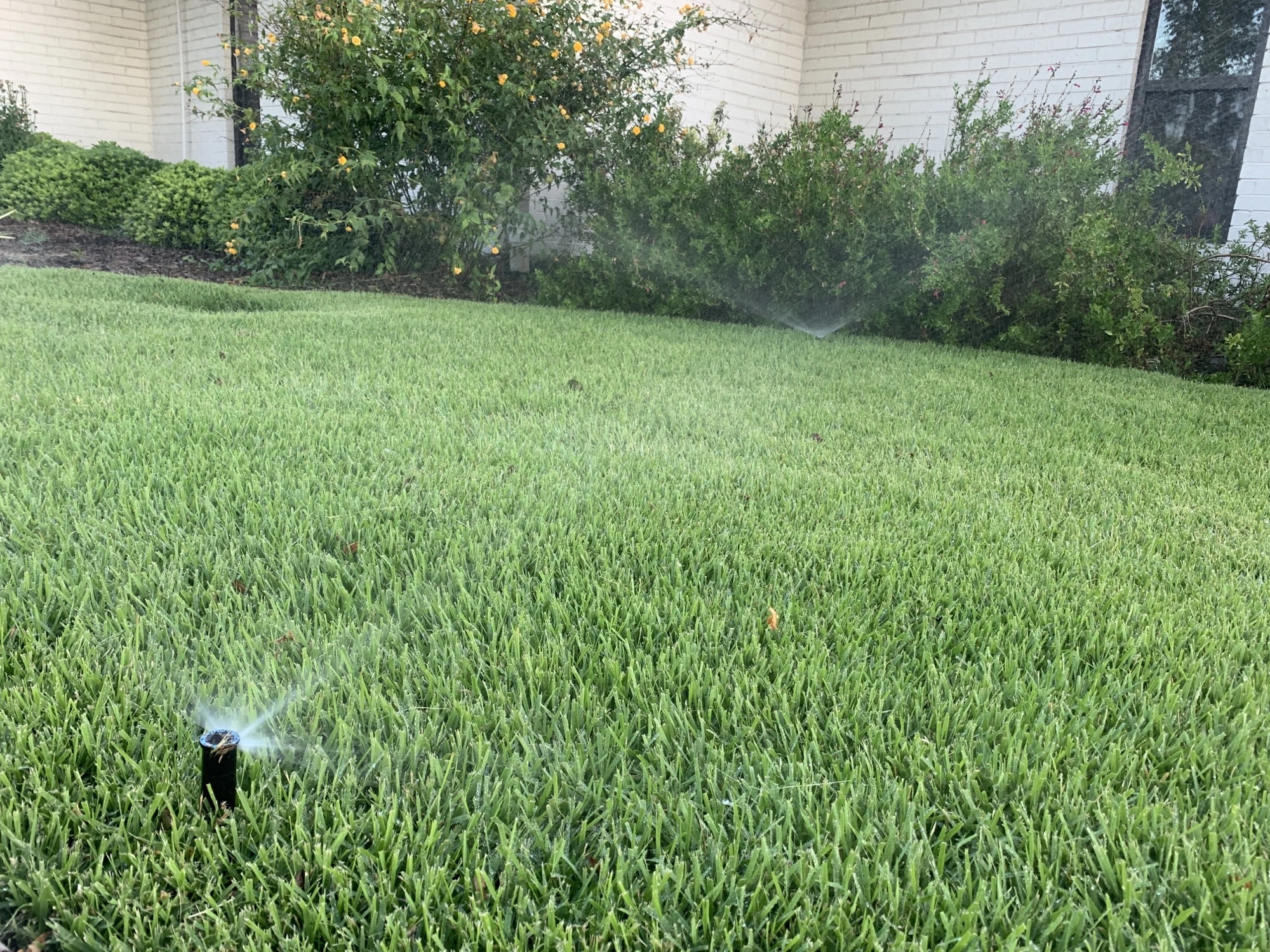Let’s face it. Weeds in your lawn are an eye-sore. If you didn’t think so, you wouldn’t be here!
In this article, we will find out about the types of lawns we have in Texas, the growth pattern, and the identification of specific weeds, and determine how to treat them. So if you want your lawn to be the best in the neighborhood, keep reading.
Benefits of an Amazing Lawn
Did you know that a beautifully maintained lawn and landscape can help to increase the value of your home by as much as 10-20%? A weed-free lawn and outdoor living space will also speed up the sale of a home as it’s usually the first thing homebuyers see when they pull up to your property. That first impression is everything!

But, where should you begin? You know you want to hire a professional lawn care company to handle it for you, but you don’t want to leave the details to just anyone. If you’re going to make a knowledgeable decision, it’s best to know the basics of how to care for and protect your grass.
Types of Texas Turfgrasses
Here in Plano, Texas, we are in USDA Hardiness Zone 8a. Knowing this number is one of the basic starting points of identifying which plants are most likely to thrive at a location and is based on the average annual minimum winter temperature.
In the South, we can competently grow warm-season grasses, which grow best in temperatures between 80-95 degrees Fahrenheit. On the other hand, cool-season grasses grow optimally in temperatures between 60-75 degrees. Some Northern parts of Texas are close to the transition zone, and that makes it challenging to grow anything well due to the unpredictability of frosts and low temperatures.
The top 3 types of turfgrasses that we see on residential properties are Bermuda, Zoysia, and St. Augustine. Let’s explore the differences in each of them.
Differences in Bermuda, Zoysia & St. Augustine Turfgrasses
Bermudagrass
Bermudagrass is extremely drought-tolerant, meaning it can withstand the hot summer sun and lack of rainfall. It reaches maturity fairly quickly when seeded into the soil. Once it’s established it can hold up against a lot of traffic and has a tolerance to low mowing heights. Bermudagrass does need a lot of specially formulated fertilizers to look its best and as a result, requires frequent mowing.
Zoysiagrass
Zoysiagrass is very diverse and includes at least 11 different species that can be used to build a lawn. It thrives in shade and doesn’t require as much fertilizer as other grass plants. Since the roots are shallow, zoysiagrass may not be as tolerant to drought.
St. Augustine
St. Augustine grass has deep roots and can withstand both shade and drought and is one of the more popular choices for residential lawns.
Grass Blends
As you can tell, each grass type has its own strengths and weaknesses. Determining which one is best for your yard is an important part of the lawn care process. Keep in mind that sometimes this may vary. Your backyard could be completely shaded by large trees, and the front yard gets full sun. In this case, grass blends work very well.
We also recommend grass blends for their higher resistance to disease, drought, pests, and herbicides. Let’s say, for example, your lawn gets infected with a fungus that only St. Augustine contracts, the rest of your lawn will stay intact. This is a great benefit, however, it also makes it tricky to manage weeds in a blended yard.
Understanding the types of weed control products and how they work will give you a better idea of what it takes to treat them.
Classifying Weeds of Texas Turf
Weeds can be categorized into 3 different botanical groups of annuals, biennials, and perennials. These are indicators of a weed’s lifecycle, growth, and reproduction strategy. Having this basic understanding is one of the first best practices for defeating them.
Classifying Weeds by Lifecycle
Annual Weeds
Annual weeds germinate from seeds each spring. After maturing, they drop seeds before dying. These are the seeds that germinate the following year. Crabgrass is an example of an annual weed.
Perennial Weeds
Perennial weeds do not die at the end of a growing season. They lay dormant in the winter but will pop up again in the spring. Dandelions are an example of a perennial weed.
Biennial Weeds
Biennial weeds are a bit of a combination. They grow vegetation in the first year and then flower and die the second year. Bull Thistle is an example of a biennial weed.
Classifying Weeds by Appearance
Even if you can’t think of the specific name of a weed, you can probably place it under one of two umbrellas: broadleaf or grassy.
Broadleaf Weeds
Broadleaf weeds are the most common culprit that homeowners hate to see in their lawn. They’re easily identifiable because their leaves are broad (imagine that!) and they don’t look like grass. They always have a main vein in the center leading to smaller veins that branch out from it. Examples of broadleaf weeds include chickweed, clover, dandelions, and violet.
Grassy Weeds
Grassy weeds are tougher to identify because they can often resemble grass. In fact, in some growing zones, our treasured bermudagrass is considered an invasive weed! Grassy weed blades have a single leaf with long, parallel veins. Their round stems have alternating leaf blades on each side.
Often herbicides are designed to be effective against one of these groups, so that’s a great place to start. But don’t stop there – you want to know your stuff, right? If so, it’s important to be able to identify specific weeds in each group so that you can choose the best product for a particular species and apply it at the right application rate.
Applying Proper Weed Control onto Texas Lawns
Now, this is typically the part you call a professional for. But we’re going to let you in on a few secrets of weed control so strap on your seatbelt and get ready!
Remember all that talk about weed life cycles and reproduction strategies? Well, that comes in handy now to determine what product to use during a specific time in the season. A Texas weed control service can help you not only identify the weeds that are prone to developing in your yard but also keep them at bay by using a combination of pre-emergents and post-emergents on a regular schedule.
Pre-Emergent Herbicides
Pre-emergents are applied to the soil before the weed starts to germinate. It essentially forms a thin, invisible barrier that blocks seeds from germinating.
Post-Emergent Herbicides
Post-emergents are applied when a weed has already made its ugly face appear in your yard. When you can visibly see it, you have two options to control it – contact or systemic.
Contact Control
Herbicides that work on contact will destroy the portions of the weed that they touch. Contact control herbicides work exceptionally well for annual weeds.
Systemic Control
Systemic herbicides will spread within the weed as it is absorbed, making this type of control very effective for perennial weeds.
Sometimes you need a combination of all four of these types of products for very stubborn weeds. Sedges, which are a type of grassy weed, can be very hard to eradicate so proper identification of the weed is key.
Weed Identification
Well, we hate to judge…but the ugliest weeds in our area are dandelions, crabgrass, chickweed, and clover. We treat them for our clients and we’ve come to learn a lot about them along the way.
Dandelions
Dandelions are a perennial broadleaf weed that grows almost anywhere but loves moist sites with ample sunlight.
Crabgrass
Crabgrass is a summer annual grass that is so hardy you can see it growing in barren places like sidewalk cracks.
Chickweed
Chickweed has a fibrous and shallow root system with white flowers.
Clover
Clover is a creeping perennial weed that is visible almost year-round. It can commonly be found in areas with low soil fertility.
Congratulations! You now have all the basics you need to go out and make an educated decision about who will help you keep the weeds out of your lawn! But don’t stop with just weed control, consider a full-service company for every aspect of maintenance.
Year-Round Turf Care Services
For a beautiful, thriving, weed-free lawn it’s more than installing sod and walking away. Just like a houseplant or your child, you have to make sure that you have a plan for your lawn and you take good care of it!

Some best practices for all turf include:
- Proper Mowing
- Proper Watering
- Aerating and overseeding
- Fertilization and Weed Control Program
You might notice lawns in your neighborhood may look different in appearance based on how it is being managed with those best practices in mind. Environmental factors like soil type, mowing height, watering, shade, and proximity of other plants that share the same nutrients are other common factors that change the way a lawn looks.
Want your lawn to look better than your neighbors? Call College Fund Landscaping!
About College Fund Landscaping
We can help you feed your lawn, apply a crabgrass preventer, and get rid of weeds in your lawn so that you’re able to enjoy your outdoor living space with your friends and family all year round.
From the very beginning stages of getting a quote to the final touches, College Fund Landscaping will be there to guide you, answer questions, and work diligently to provide you the best lawn care service available.
We are a recognized leader serving local Plano Texas customers with residential lawn care and weed control services. From lawn care, mowing, to landscaping and yard cleanup, you can rely on us to bring experience, beauty, and value to your lawn care project.



Comments (0)
Thanks for your comment!
Thanks for your feedback! Your comments have been successfully submitted! Please note, all comments require admin approval prior to display.
Error submitting comment!
There is a problem with your comment, please see below and try again.